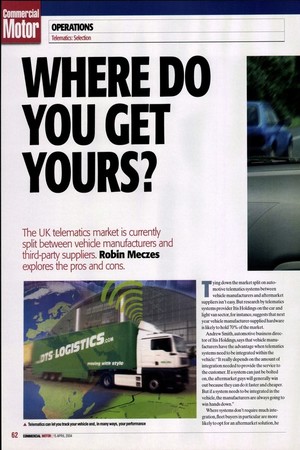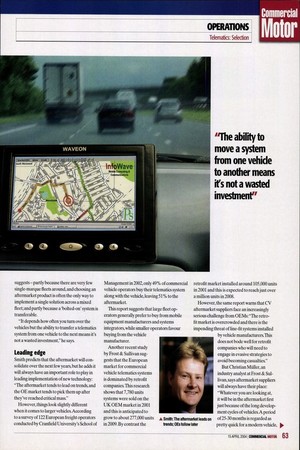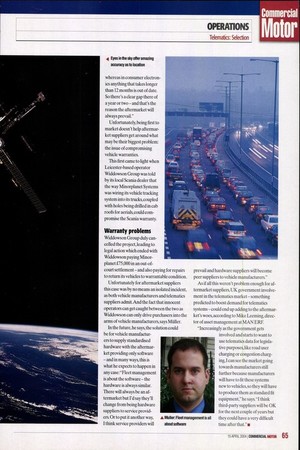WHERE DO
Page 60

Page 61

Page 63

Page 62

If you've noticed an error in this article please click here to report it so we can fix it.
YOU GET
YOURS?
The UK telematics market is currently split between vehicle manufacturers and third-party suppliers. Robin Meczes
explores the pros and cons.
Tying down the market split on automotive telematics systems between vehicle manufacturers and aftermarket suppliers isn't easy. But research by telematics systems provider Itis Holdings on the car and light van sector, for instance, suggests that next year vehicle manufacturer-supplied hardware is likely to hold 70% of the market.
Andrew Smith, automotive business director of Itis Holdings, says that vehicle manufacturers have the advantage when telematics systems need to be integrated within the vehicle:"It really depends on the amount of integration needed to provide the service to the customer. If a system can just be bolted on, the aftermarket guys will generally win out because they can do it faster and cheaper. But if a system needs to be integrated in the vehicle, the manufacturers are always going to win hands down." Where systems don't require much integration, fleet buyers in particular are more likely to opt for an aftermarket solution, he
suggests — partly because there are very few single-marque fleets around, and choosing an aftermarket product is often the only way to implement a single solution across a mixed fleet; and partly because a 'bolted-on' system is transferable.
"It depends how often you turn over the vehicles but the ability to transfer a telematics system from one vehicle to the next means it's not a wasted investment," he says. Leading edge
Smith predicts that the aftermarket will consolidate over the next few years, but he adds it will always have an important role to play in leading implementation of new technology: "The aftermarket tends to lead on trends, and the OE market tends to pick them up after they've reached critical mass." However, things look slightly different when it comes to larger vehicles.According to a survey of 122 European freight operators conducted by Cranfield University's School of
Management in 2002, only 49% of commercial vehicle operators buy their telematics system along with the vehicle, leaving 51% to the aftermarket. This report suggests that large fleet operators generally prefer to buy from mobile equipment manufacturers and systems integrators, while smaller operators favour
buying from the vehicle manufacturer. Another recent study by Frost & Sullivan suggests that the European market for commercial vehicle telematics systems is dominated by retrofit companies.This research shows that 7,780 units systems were sold on the UK OEM market in 2001 and this is anticipated to grow to about 277,000 units in 2009. By contrast the
retrofit market installed around 105,000 units in 2001 and this is expected to reach just over a million units in 2008. However, the same report warns that CV aftermarket suppliers face an increasingly serious challenge from OEMs:"The retrofit market is overcrowded and there is the impending threat of line-fit systems installed
by vehicle manufacturers.This does not bode well for retrofit companies who will need to engage in evasive strategies to avoid becoming casualties." But Christian Muller, an industry analyst at Frost & Sullivan, says aftermarket suppliers will always have their place: "Whatever you are looking at, it will be in the aftermarket first just because of the long development cycles of vehicles.A period of 25-30 months is regarded as pretty quick for a modem vehicle,
whereas in consumer electronics anything that takes longer than 12 months is out of date. So there's a clear gap there of a year or two — and that's the reason the aftermarket will always prevail."
Unfortunately, being first to market doesn't help aftermarket suppliers get around what may be their biggest problem: the issue of compromising vehicle warranties.
This first came to light when Leicester-based operator Widdowson Group was told by its local Scania dealer that the way Minorplanet Systems was wiring its vehicle tracking system into its trucks, coupled with holes being drilled in cab roofs for aerials, could compromise the Scania warranty. Warranty problems Widdowson Group duly cancelled the project, leading to legal action which ended with Widdowson paying Minorplanet £75,000 in an out-of
court settlement — and also paying for repairs to return its vehicles to warrantable condition.
Unfortunately for aftermarket suppliers this case was by no means an isolated incident, as both vehicle manufacturers and telematics suppliers admit. And the fact that innocent operators can get caught between the two as Widdowson can only drive purchasers into the arms of vehicle manufacturers, says Muller. In the future, he says, the solution could be for vehicle manufacturers to supply standardised hardware with the aftermarket providing only software — and in many ways, this is what he expects to happen in any case:"Fleet management is about the software —the hardware is always similar. There will always be an aftermarket but I'd say they'll change from being hardware suppliers to service providers. Or to put it another way, I think service providers will
prevail and hardware suppliers will become peer suppliers to vehicle manufacturers."
As if all this weren't problem enough for aftermarket suppliers, UK government involvement in the telematics market — something predicted to boost demand for telematics systems — could end up adding to the aftermarket's woes, according to Mike Leeming, director of asset management at MAN ERF. "Increasingly as the government gets involved and starts to want to use telematics data for legislative purposes, like road user charging or congestion charging, I can see the market going towards manufacturers still further because manufacturers will have to fit these systems new to vehicles, so they will have to produce them as standard fit equipment," he says."I think third-party suppliers will be OK for the next couple of years but they could have a very difficult time after that."• Pros and cons
There are several issues for truck operators to bear in mind when choosing between aftermarket and OE telematics systems. The warranty problem remains perhaps the biggest issue on the aftermarket side; very few third-party suppliers have even approached truck builders about the issues involved in wiring systems into the CAN-bus, according to Mike Leeming of MAN ERE Another issue with the aftermarket route, says Leeming, is that their systems are often about a single application -vehicle tracking being the main one for HGVs -while vehicle OEMs tend to
produce more integrated systems with greater elements of vehicle performance monitoring and diagnostics.
Vehicle OEMs are also in a position to give operators advice about that performance, he says; for example, helping an operator to analyse driving style, fuel consumption or brake wear information. Aftermarket suppliers generally have no interest or ability in this area, Leeming suggests. On the downside,
however, the greater complexity of some OEM systems and their narrower potential market inevitably leads to more expensive solutions. Leeming says a benchmark OE cost per vehicle would be around £1,600 as opposed to around £800 for a mass-market, third-party tracking system. There is also little or no choice about the precise make and model of system installed when you go the OE route. As a final consideration, OEMs do not generally offer all conceivable telematics applications. So while a truck manufacturer might supply a tracking
and communications option, for instance, it might not offer sat-nay or a stolen vehicle recovery system.
Conversely, on lighter vehicles OEMs tend to offer sat-nay and stolen vehicle recovery systems but little in the way of tracking or vehicle performance monitoring. Steve Coffin, general manager for fleet business at aftermarket supplier Siemens VDO, says a key benefit of the aftermarket route is its suitability for mixed fleets: "Some hauliers are twitchy about taking on OF devices if they are not running a one-marque fleet. OEs tend
to apply their products only to their own vehicles and where they do fit to other makes, they have no more expertise than the aftermarket suppliers."
Taken as a whole, the aftermarket gives users a much wider choice of system than the OE sector, Coffin adds. And although some aftermarket suppliers offer only a single telematics application, he concedes, a growing number his own firm included do offer multiple products: "So people can pick and choose from a single aftermarket range whose component parts are designed to fit together."
























































































































































































